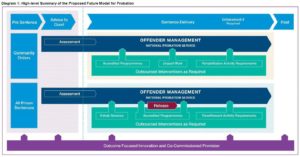This is the final post in a blog mini-series in which I am working through the detail of the main topics in the operating blueprint for the new probation system which HMPPS published on 14 June.
Today, I am focusing on the last four topic areas in the blueprint:
- Vulnerable Offenders
- Workforce development
- Digital technology
- Performance Framework
Vulnerable offenders
This section of the blueprint acknowledges that the original version of Transforming Rehabilitation did not cater sufficiently for the needs of specific groups of offenders; particularly women, those from BAME backgrounds and those with protected characteristics. The MoJ consulted on how best to meet the particular needs and vulnerabilities of different cohorts of offenders and those who participated in the consultation made five yet points:
- The importance of personalised sentence plan, considering both criminogenic needs and protected characteristics.
- A focus on particular cohorts must not be allowed to mitigate against a whole system, problem-solving approach. While there is a need for some specialist services to respond to diverse groups, those needs are often best met if all mainstream services are sufficiently responsive and flexible.
- The relationship with the supervisor/ probation officer is key.
- Often the best delivery mechanism is outside probation and more use should be made of the voluntary sector.
- Much is already in place but under-used; particularly treatment requirements and peer mentoring.
The blueprint promises better data collection around equalities and that bidders will need to demonstrate that they will meet the needs of different cohorts.
Workforce
The blueprint sets out four key challenges of the current system:
- High workloads for staff and limited scope and incentives for joint workforce planning across the system.
- Low staff morale, a sense of being undervalued and the de-professionalisation of probation.
- Recruitment and retention issues in some areas of probation.
- Inconsistent and undefined training pathways across the system.
The blueprint sets out a series of measures intended to re-professionalise the probation service including:
- A mandatory probation qualification for all responsible officers.
- A full induction for CRC staff moving to the NPS.
- A standard framework for Offender Management of low, medium and high-risk offenders to ensure all grades of staff have the capacity to manage risk and need.
Digital and technology
The blueprint promises an investment in digital services with the same two core systems: OASys to assess risk and needs and National Delius for case management. New providers will be able to use these systems and will be required to guarantee that their own infrastructure is secure.
Apart from this commitment to a more joined-up service, there are no details of any substantive modernisation or innovation in the blueprint.
Performance framework
The blueprint sets out three key objectives in this area:
- Focus on Quality – rebalancing the focus from processes to quality delivery by introducing new quality measures and strengthening provider quality assurance.
- Incentivising outcomes likely to reduce offending – by capturing improvements related to offending over which providers have an element of control and for which there is evidence of a link with reduced reoffending.
- Getting the Basics Right – by holding the NPS and contracted providers to account on sentence delivery and protecting the public and, therefore, promoting sentencer confidence in probation delivery.
I read this as saying that there will be a form of payment by results in the new contracts with the Innovation Partners but there are, as yet, no clues on what the key outcomes will be.
There is a list of key performance areas for Unpaid Work and Accredited Programmes (which will be the two areas of work outsourced to “Innovation Partners” in the ten English and one Welsh probation regions.
Conclusion
As HMPPS makes clear in its introduction, this blueprint is still a long way from a “Target Operating Model” which many more details to be worked out in terms of detailed operational issues, contractual expectations and payment mechanisms. As in the first version of TR, the MoJ is on an incredibly demanding timescale to get everything in place in time for a procurement competition due to start later this year.
Thanks to Andy Aitchison for kind permission to use his image in this post. You can see Andy’s work here.







One Response
MOJ do IT really badly for years, confidence is not there that anything will be different. So much money wasted